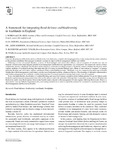JavaScript is disabled for your browser. Some features of this site may not work without it.
| dc.contributor.author | Morris, Joe | - |
| dc.contributor.author | Hess, Tim M. | - |
| dc.date.accessioned | 2011-10-12T23:04:14Z | |
| dc.date.available | 2011-10-12T23:04:14Z | |
| dc.date.issued | 2005-01-01T00:00:00Z | - |
| dc.identifier.citation | J. Morris; T. M. Hess; D. J. G. Gowing; P. B. Leeds-Harrison; N. Bannister; R. M. Vivash; M. Wade, A framework for integrating flood defence and biodiversity in washlands in England, International Journal of River Basin Management, 2005, Vol. 3. No. 2; pg 1-11 | - |
| dc.identifier.issn | 1571-5124 | - |
| dc.identifier.uri | http://dspace.lib.cranfield.ac.uk/handle/1826/1965 | |
| dc.identifier.uri | http://www.jrbm.net/pages/ | |
| dc.description.abstract | Concerns about increased flood risk and loss of biodiversity in lowland areas, coupled with changing priorities in the countryside have drawn attention to the potential contribution that managed washlands can make to improved flood management, habitats and wildlife. Following a review of research literature, a survey of flood managers and conservation officers, and an evaluation of selected case sites in England, a framework to help integrate potential flood management and biodiversity opportunities was constructed. This framework consists of three components, namely: a Hydraulic classification which categorises washlands according to degree of hydraulic control; a Habitat classification which captures attributes of washland hydrology that define the type of existing or potential habitats; and, a Menu of Interventions to “engineer” or manage particular flooding and soil wetness regimes and thereby better exploit habitat potential. Washlands were also categorised by main type of benefit whether this is flood management, conservation, or in the case of integratedwashland, a balance of the two. The advantages of alternative administrative and funding arrangements for washlands, whether land acquisition or annual payment to existing land owners, were also explored. It was concluded that the classification of washland flooding and water level regimes can help to define habitat potential. It can also help to guide hydraulic engineering and management actions that can be taken to realise this potential. Although there is potential synergy between flooding and biodiversity under some flood regimes, biodiversity benefits mainly depend on the management of water regimes following flood events. There is a clear need to “join up” hitherto fragmente | en_UK |
| dc.publisher | Jrbm | en_UK |
| dc.subject | flood defence | en_UK |
| dc.subject | biodiversity | en_UK |
| dc.subject | washlands | en_UK |
| dc.subject | floodplains | en_UK |
| dc.title | A framework for integrating flood defence and biodiversity in washlands in England | en_UK |
| dc.type | Article | - |
